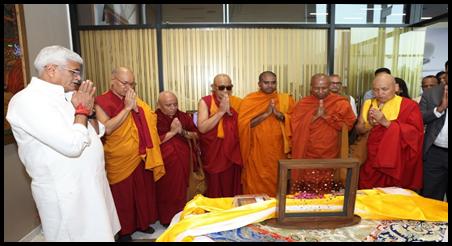In an event that stirred hearts across the global Buddhist community, India welcomed home the sacred Piprahwa relics—one of the most spiritually and archaeologically significant treasures ever discovered. Repatriated after 127 years, these relics represent not just fragments of the past but a powerful symbol of India’s enduring cultural legacy and soft power diplomacy.
The journey of these relics, taken during colonial rule, came full circle in July 2025, as the Ministry of Culture, in collaboration with Godrej Industries Group, orchestrated their return. These relics had surfaced at an international auction—until a decisive intervention halted their sale and brought them back to their rightful home.
Unearthing the Sacred: Piprahwa Relics
The Piprahwa Relics are a collection of sacred artefacts discovered in 1898 at the Piprahwa Stupa in Uttar Pradesh. It is the site believed to be associated with ancient Kapilavastu, the homeland of Gautama Buddha.
These relics, unearthed by British colonial engineer William Claxton Peppé in 1898, include bone fragments believed to be those of Lord Buddha, along with crystal caskets, gold ornaments, gemstones, and a sandstone coffer.
An inscription in Brahmi script on one of the caskets links the relics directly to the Sakya clan, to which Buddha belonged, indicating that these remains were enshrined by his followers around the third century BC. Further excavations by the Archaeological Survey of India between 1971 and 1977 uncovered additional steatite caskets containing 22 sacred bone relics, which are now preserved at the National Museum in New Delhi.
Homecoming After 127 Years
Prime Minister Narendra Modi celebrated the repatriation of the Piprahwa relics, describing it as a proud moment for the nation’s cultural heritage.
In a post on X (formerly Twitter), PM Modi said, “It would make every Indian proud that the sacred Piprahwa relics of Bhagwan Buddha have come home after 127 long years. These sacred relics highlight India’s close association with Bhagwan Buddha and his noble teachings. It also illustrates our commitment to preserving and protecting different aspects of our glorious culture.”
Pirojsha Godrej, Executive Vice Chairperson of Godrej Industries Group, expressed pride in contributing to this milestone, describing the Piprahwa relics as timeless symbols of peace, compassion, and humanity’s shared heritage.
The relics will soon be unveiled in a public ceremony, allowing citizens and global visitors to connect with these sacred artefacts.
India’s Buddhist Heritage and Cultural Diplomacy
In the 6th century BCE, Siddhartha Gautama attained enlightenment, becoming the ‘Buddha’ and initiating the spread of his teachings, known as Buddha Dhamma.
After his Mahaparinirvana, his followers preserved and propagated these teachings, leading to the development of three major Buddhist traditions: Theravada, Mahayana, and Vajrayana. Emperor Ashoka (268-232 BCE) significantly advanced Buddhism by integrating its principles into his governance.
India’s deep-rooted Buddhist heritage, stemming from the teachings of the Buddha and his followers, has significantly shaped its cultural identity and fostered unity across Asia by promoting shared values of life, divinity, and social harmony. This legacy strengthens India’s foreign policy and diplomatic relations, encouraging mutual respect and cooperation among nations.
How India celebrates and safeguards Buddhist heritage?
India, the birthplace of Buddhism, celebrates International Abhidhamma Divas to honour Lord Buddha’s profound philosophical teachings, particularly the Abhidhamma, which emphasises mental discipline and self-awareness.
To preserve and promote this heritage, India has launched initiatives including the Buddhist Tourism Circuit under the Swadesh Darshan scheme, which develops key Buddhist sites such as Kapilvastu, enhancing cultural tourism and reinforcing India’s historical connection to Buddhism.
Further solidifying its commitment to Buddhist heritage, India granted classical status to the Pali language on October 4, 2024, recognising its historical role as the medium of the Buddha’s sermons. Such initiatives reflect India’s dedication to celebrating and preserving its Buddhist culture, fostering global dialogue, and promoting peace and harmony through shared heritage.
This homecoming is celebrated throughout the country as a triumph of India’s cultural heritage, emphasising the government’s commitment to protecting these sacred artefacts. The relics, originally taken abroad during the colonial era, are now back in India, symbolising the nation’s enduring connection to Buddha’s teachings.














